Basic screens & buttons of the Apple Watch
Posted by Wesley on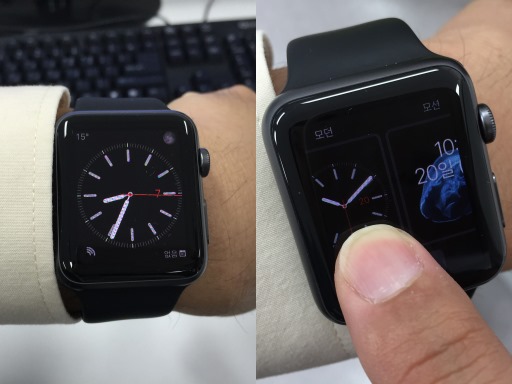
You can select from 10 watch faces and customize the complications
Apple Watch can do many things, but it is first a wristwatch. Naturally, the watch face is the default screen of the device. It is customizable, but in order to do so you need to know a new touch screen interaction method called Force Touch. Basically, you press on the screen as if to push a stiff button. Once you do that on the watch face, you can browse through ten choices which includes various analog, digital, and celestial faces.
After choosing a watch face, it can be further customized. The complications around the time display can be set to show various information, which includes the day of the month, upcoming schedule, temperature, workout progress, and the phase of the Moon. Some of the elements of the watch can also have their colours changed and the styles of some of the analog faces can be altered.
At the time of the writing, 3rd party custom watch faces cannot be loaded into the watch. But the UI seems to suggest that this may become possible in the future; you can add or subtract the existing choices. Having ten choices with varying levels of tweaking might not leave a massive amount of choices, but at least they are pretty solid ones that can get you by for the time being.
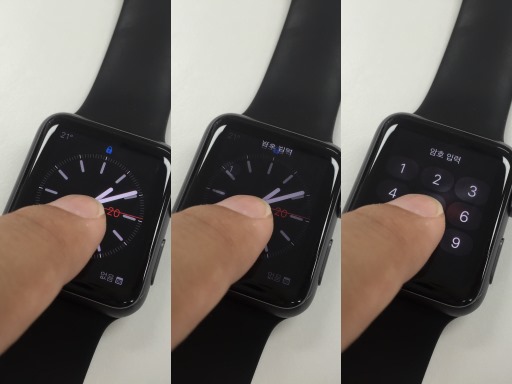
Touching the screen when Apple Watch is locked
I've talked about the locking of the watch previously. This happens if you set up a passcode and the device is removed from your wrist. As long as it's on your wrist, it assumes that the user is the rightful owner and stays unlocked.
If it does get locked, the time telling functionality is the only thing that remains functional. Attempting any interaction results in prompting for the passcode as you can see here. You can either enter the correct passcode, or unlock the paired iPhone to authenticate your identity and regain normal functionality.
Currently, like the rest of the wristwatches or smart watches, Apple Watch lacks an activation lock that prevents anyone stealing it from resetting it and using it as one's own. However, the passcode and lock should guard your personal information from someone trying to peek through the device.
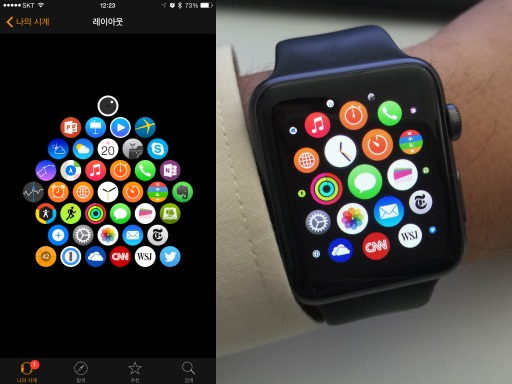
Apps arranged on the Apple Watch app (left) and how it's really shown (right)
There are two hardware control buttons on the Apple Watch. The round one is the digital crown, and the long one next to it is the side button. The digital crown is basically iPhone's home button with the scroll wheel functionality, as you can scroll through pages by turning the crown. Press it once while the screen is on to bring up the "home screen" with app icons as you see here.
You can launch any apps loaded to the watch from here. The ones that didn't get to be shown due to the limited screen size can be found by dragging the screen and moving the app matrix around. The icons can be arranged either on the watch itself or on the Apple Watch app.
If you press the digital crown twice quickly, it'll bring up the last run app. It's similar to how clicking the home button twice brings up the multitasking screen on an iPhone, except you're switching to the previous app automatically. Lastly, pressing the button long will bring up Siri, exactly like an iPhone. So making the digital crown - home button connection should make it easier to use.
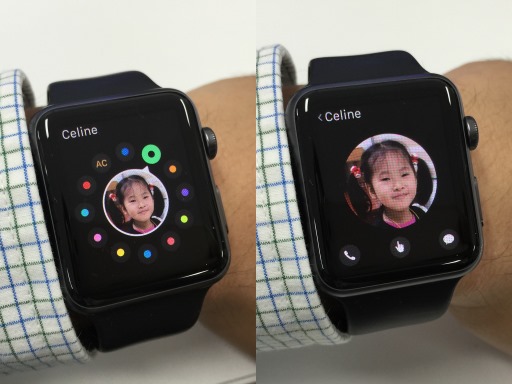
Pick a contact from the ring of favourites (left) for quickly contacting the person (right)
The side button can be said to be a souped-up power button. If you press it long, you can completely turn the device off, get it into the power saving mode, or just lock it. But generally, you won't use this much as it has other, more active uses. Its primary function, brought up when pressing the button once quickly, is to load the ring of favourite contacts, as you can see here.
Once this screen is shown, you can spin through the contacts using the digital crown or choose the contact dot by touch. The chosen contact will have contacting options shown at the bottom of the screen - you can make a phone call, send something called "Digital Touch", or text via voice recognition, predetermined messages, or emojis. Basically, it's like having a wristwatch phone.
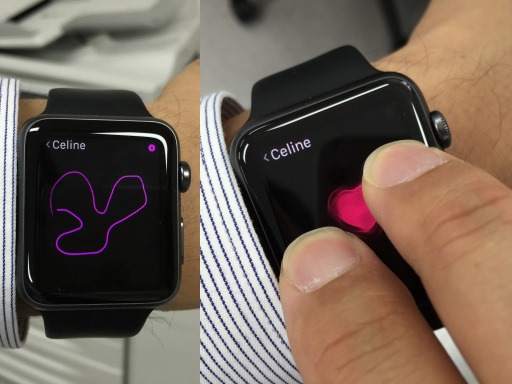
The Digital Touch - send a soon-disappearing drawing (left) or your heartbeats (right)
[Added: 2015-05-22] The Digital Touch is something you can send to someone else who has an Apple Watch, which is ephemeral and instant in nature. You could draw a doodle which disappears after a few moments with your fingers or, send a tap by... tapping the screen. If you press the screen with two fingers, you can let the other user feel your current heartbeat.
It's a fun way to interact with a fellow Apple Watch user, but also very gimmicky and not really interesting after the novelty value wears off. It's also accessible only from the contact ring - you cannot send it from other apps like the Phone or Messages. [/Added]
If you have Apple Pay compatible card loaded on your iPhone, you can double-click the side button to bring up Apple Pay functionality on the watch. Unfortunately, this is still a US-only feature as of this writing and the double-clicking will do nothing on mine.
In the next post, I'll take a look at some of the basic interactions you'll be doing a lot with the device.
Defined tags for this entry: Apple Watch, watch